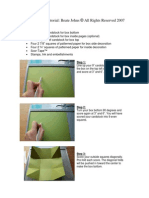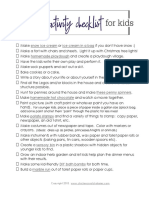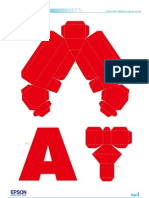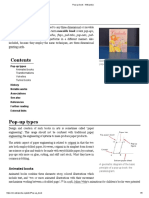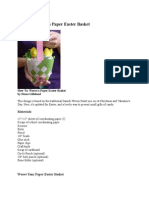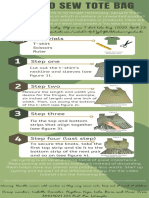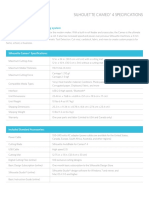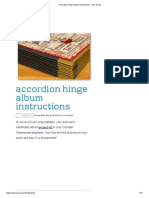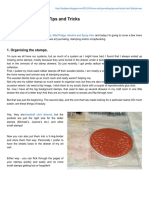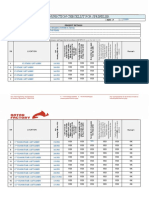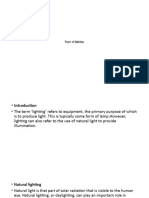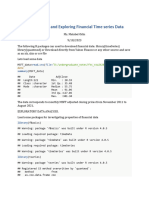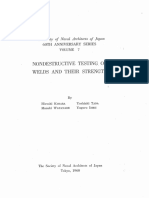Build A Model Cardboard House - 10 Steps - Instructables
Build A Model Cardboard House - 10 Steps - Instructables
Uploaded by
sifiso siamendaCopyright:
Available Formats
Build A Model Cardboard House - 10 Steps - Instructables
Build A Model Cardboard House - 10 Steps - Instructables
Uploaded by
sifiso siamendaOriginal Title
Copyright
Available Formats
Share this document
Did you find this document useful?
Is this content inappropriate?
Copyright:
Available Formats
Build A Model Cardboard House - 10 Steps - Instructables
Build A Model Cardboard House - 10 Steps - Instructables
Uploaded by
sifiso siamendaCopyright:
Available Formats
(/) Circuits (/circuits/) Workshop (/workshop/) Craft (/craft/) Cooking (/cooking/) Living (/living/) Outside (/outside/) Log In (/account/login/)
|
Sign Up
Teachers (/teachers/) (/account/register/)
instructables (/craft/)
craft
Projects (/craft/projects/) Contests (/contest/) Let's Make...
Build a Model Cardboard House
By mddutton (/member/mddutton/)
in Craft (/craft/) > Cardboard (/craft/cardboard/projects/) 29,649 17
Download Favorite
auto=webp&frame=1&width=1024&height=1024&fit=bounds&md=e583a86bb37fb680c482837a59cb8c9d)
(https://content instructables com/ORIG/FJH/1VSS/K2JDBOZJ/FJH1VSSK2JDBOZJ jpg? auto=webp&frame=1&width=1024&height=1024&fit=bounds&md=cfcebdd8da7
(https://content instructables com/ORIG/FBO/AFOM/K2JDBOZ2/FBOAFO
In this project we will be building a model house out of cardboard! Having a visual
representation or model of structures can make it a lot easier for people to understand your
design. This project is particularly for students in grades 9-12 - at the high school level students
should already have a lot of experience in recognizing different structures, but we want to look
at these structures in greater depth. One aspect of this is having students design structures and
make models of them, which is what we will focus on in this project.
The plan here is to use a common/ easily-available object as a sort of pre-fabricated structure
and then build off of it. In particular this project uses a tissue box, which we can imagine as a
shed or popular tiny home or other structure, and then we will alter that structure to give it a
new intended use: a larger inhabitable space.
This project works with STL #20 which states that "students will develop an understanding of
and be able to select and use construction technologies."
We will look specifically at benchmarks M and N:
M. Structures require maintenance, alteration, or renovation periodically to improve them or to
alter their intended use.
N. Structures can include pre-fabricated materials.
Learning Objectives:
- Learn the importance of alterations and renovations in construction, and why they might be
necessary
- Utilize tools to produce a visual model of a structure
Add Tip V Ask Question | Comment Download
Step 1: Gathering Materials
auto=webp&frame=1&width=1024&height=1024&fit=bounds&md=fb8199f3e158cfac19fb50aa013ed19e)
(https://content instructables com/ORIG/FNJ/MMTB/K2JDBOZZ/FNJMMTBK2JDBOZZ jpg? auto=webp&frame=1&width=1024&height=1024&fit=bounds&md=4124ad27e239
(https://content instructables com/ORIG/FBA/95N0/K2JDBOZN/FBA95N
For this project you will need:
- Tissue box
- Scrap cardboard/ cardboard boxes
- Printer paper
- Liquid glue & glue sticks
- Ruler
- X-Acto knife
- Pen
- Pencil
- Scissors
Cost Estimation:
Tissues..................$1.64
Scissors.................$4.88
Glue........................$3.48
Ruler.......................$0.99
X-Acto knife.........$3.67
Add Tip V Ask Question | Comment Download
Step 2: Sketching & Planning
auto=webp&frame=1&width=1024&height=1024&fit=bounds&md=2ca6b61e523aa15e7f0fb7482240972a)
(https://content instructables com/ORIG/FUD/0BNA/K2JDBOZ5/FUD0BNAK2JDBOZ5 jpg?
The tissue box being utilized is 4-3/8" x 4-3/8" x 5", so we want to try and keep this scale when
building our house. I have designed a two-story house that will almost triple the width of our
"pre-fabricated structure" (the tissue box) and meet the requirements of a larger inhabitable
space. The sketch above gives elevation views of each side of the house (front, right, back, and
left) as well as measurements of walls lengths and planned location of windows and doors.
Add Tip V Ask Question | Comment Download
Step 3: Measuring Out the Pieces
auto=webp&frame=1&width=1024&height=1024&fit=bounds&md=496ffbaaf5
(https://content instructables com/ORIG/FLG/YB2P/K2JDBOZD/FLGYB
auto=webp&frame=1&width=1024&height=1024&fit=bounds&md=75ac49be2f3
(https://content instructables com/ORIG/FEO/6RVV/K2JDBOYX/FEO6R
auto=webp&frame=1&width=1024&height=1024&fit=bounds&md=777b1a085ec88209cbc81021142254cc)
(https://content instructables com/ORIG/FT9/BNU5/K2JDBOZI/FT9BNU5K2JDBOZI jpg?
Once we have the plan of what we want the house to look like and how big it will be, we can
start transferring that information to the cardboard. Use a ruler to measure out the correct
dimensions for each piece, and use a pencil to mark those dimension lines.
We will have 8 pieces for the base of the house:
- One 11-7/8” x 11-1/2”
- One 6” x 11-1/2”
- One 8-1/4” x 10-1/2”
- One 5-3/4” x 10-1/2”
- One 1-1/2” x 10-1/2”
- One 4-3/8” x 5-1/2”
- Two 3-1/8” x 6-1/2”
Use the scissors to cut out each of these pieces, and optionally use the X-Acto knife to trim off
any jagged edges. As you cut out each piece it is a good idea to write the dimensions of them on
their backs so that they can be easily found later on.
(Our roof pieces will be measured and cut out in a later step.)
Add Tip V Ask Question | Comment Download
Step 4: Cut Out Space for the Roof
auto=webp&frame=1&width=1024&height=1024&fit=bounds&md=384bace943
(https://content instructables com/ORIG/FZF/6S0T/K2JDBOZ4/FZF6S
auto=webp&frame=1&width=1024&height=1024&fit=bounds&md=96b38e81e41da30bb01fb22d7818d2c6)
(https://content instructables com/ORIG/F88/ZG8S/K2JDBOZV/F88ZG8SK2JDBOZV jpg?
Several of our pieces will need to be cut at an angle to make room for the slope of the roof we
are going to construct. Start with the 6” x 11-1/2” piece - mark at the top of the piece where the
midpoint is, which should be at 3”. We will draw a horizontal line an inch (1”) down from the top
of the piece, and the draw a diagonal line on either side from the midpoint down to the
endpoints of that line. Then cut off the two triangles made in each corner.
This same process will be repeated for 3 other pieces.
On the 11-7/8” x 11-1/2” piece, first mark a point six inches (6”) from the left edge to represent
the opposite wall of the piece we just cut. Since these two wall segments should be equal, use
the same 3” midpoint mark and draw two diagonal lines down to the endpoints. The one inch
(1”) line down from the top will be cut off as well, from the six inch mark to the other side of the
piece. This is shown in the third image above.
The other two pieces have the same dimensions - the midpoint will be half of 3-1/8", so mark at
1-9/16" and cut the diagonal so it reaches your one inch (1") mark.
Add Tip V Ask Question | Comment Download
Step 5: Assembling the Pieces
Once we have our 8 pieces cut out we can start to assemble them and glue them together. We
will look at our design plan to make sure we have them connected in the correct layout. For
assembly, put glue along the edges of the pieces and hold them together until the glue starts to
get a bit tacky. Connect the tissue box to the back wall in this step, applying a layer of glue on
one side of the box and aligning it with the edge of the wall.
Add Tip V Ask Question | Comment Download
Step 6: Making a Base
auto=webp&frame=1&width=1024&height=1024&fit=bounds&md=48e02747196052258cc5d22001d7a168)
(https://content instructables com/ORIG/FQB/BUW3/K2JDBP09/FQBBUW3K2JDBP09 jpg? auto=webp&frame=1&width=1024&height=1024&fit=bounds&md=
(https://content instructables com/ORIG/F4D/R03I/K2JD
To make our house construction sturdy, we will add a base beneath the whole structure. Begin
by taking a large sheet of cardboard and placing the house base on top of it. Using a pencil,
trace an outline of the house about an inch out from the walls. Once you have your outline you
can cut out the shape and then add glue to the bottoms of the walls and stick them to the base.
Add Tip V Ask Question | Comment Download
Step 7: Measuring Out the Roof
auto=webp&frame=1&width=1024&height=1024&fit=bounds&md=b405f8bb7e
(https://content instructables com/ORIG/FI1/X8U4/K2JDBPGM/FI1X8U
3 More Images
auto=webp&frame=1&width=1024&height=1024&fit=bounds&md=00e6954ed0cd16a46ea522a206dba092)
(https://content instructables com/ORIG/F2U/4I15/K2JDBOZU/F2U4I15K2JDBOZU jpg?
We will create a simple gable roof that utilizes 4 separate pieces. To get a new texture for roof
shingles we can remove the top layer of cardboard, thus revealing the ridges in-between the
layers. Flip the ridges over so that we can mark our measurements along the smooth side.
Two pieces will be made for the 6" wall, and two pieces will be made for the 4-3/8" wall (on top
of the tissue box). The former will have the dimensions of 3-1/2" x 8-1/2" - having them equal
slightly over 6" will allow for an eave, which is an overhang of the roof over the wall face. Glue
these along the diagonal cuts we made earlier.
The latter two pieces will have the dimensions of 2-1/4" x 9", also creating an eave. We also have
to account for the diagonal created by our roof pieces we've already glued in place. Since this is
the case, we will start at one corner and draw a 4-1/8" diagonal line as shown in the above
picture. We will cut this triangle off and repeat the process, albeit opposite, on the remaining
piece. Then just glue these down.
Add Tip V Ask Question | Comment Download
Step 8: Making Doors and Windows
2 More Images
auto=webp&frame=1&width=1024&height=1024&fit=bounds&md=6dd323395df4ed5de9030b73f0c9b212)
(https://content instructables com/ORIG/F6C/CNF3/K2JDBOZA/F6CCNF3K2JDBOZA jpg? auto=webp&frame=1&width=1024&height=1024&fit=bounds&md=c05a83b228d
(https://content instructables com/ORIG/FZE/R3AQ/K2JDBP08/FZER3A
Doors:
Our design has 4 doors - one on our "original" building (the tissue box), one on the second floor
above the tissue box, one on the right side of the house, and a final door in the back. Each of
these will be 1-3/4" x 4-1/8", except for our second floor door. Since this one will be a double
sliding door it will be a bit wider, specifically 2-1/2" x 4-1/8". Once these are cut out you may use
a marker or pen to draw details - I added a frame and door handles.
Windows:
This design also has a lot of windows, coming in at 23 - two sizes of double-hung windows, fixed
windows for next to the doors on the front of the house, and rounded windows for under the
roof.
The smaller double-hung windows (with the 2x2 grid design) are dimensioned as 1-1/2" x 1-1/2"
and there will be 15 of these. The larger double-hung windows (with 3 panels) are dimensioned
as 2-1/2" x 1-1/2" and we will have 3 of these. There's a total of 5 fixed windows, dimensioned as
1" x 2-1/2", and 2 rounded windows that have a diameter of 1" each. The same marker or pen
may be used to draw the frame as well as the panes of glass.
Add Tip V Ask Question | Comment Download
Step 9: Making a Balcony & Attaching Elements
auto=webp&frame=1&width=1024&height=1024&fit=bounds&md=d8342879f45
(https://content instructables com/ORIG/F7Q/L1ID/K2JDBP02/F7QL1
3 More Images
Cut out a piece of cardboard that is 1" x 6-1/4" - this will act as our balcony railing. An inch (1") in
on either side, use the X-Acto knife to create a vertical slice, but do not go all the way through.
These will be our folding lines - from here simply glue to the top of the tissue box and the front
wall.
At this point we can also attach our doors and windows! Reference the initial plan and the
photos above so that there are 10 windows in the front, 4 windows on the left side, 4 windows
on the right side, and 6 windows in the back. Make sure to keep them level, and have a bit of
space in-between the levels so that it looks like a two-story house.
Add Tip V Ask Question | Comment Download
Step 10: Finish!
auto=webp&frame=1&width=1024&height=1024&fit=bounds&md=321079653c47e26447a90bbdae634
(https://content instructables com/ORIG/FOS/G4DM/K2JDBOZO/FOSG4DMK2JDBOZO jpg?
Add Tip V Ask Question | Comment Download
Be the First to Share
Did you make this project? Share it with us!
I Made It!
Recommendations
(/Scrap-Fabric-Rope-Bag/) (/Cardboard-Cruiser-Card-Stock-Airplane/)
Scrap Fabric Rope Bag (/Scrap-Fabric- Cardboard Cruiser Card Stock Airplane
Rope-Bag/)
by Brooklyntonia (/Cardboard-Cruiser-Card-Stock-
(/member/Brooklyntonia/)
in Fiber Arts Airplane/)
by zdedesigns
8
9
930 (/)
105
8
8.9K
(/contest/meatless/) (/contest/fta072022/)
Add Tip
V Ask Question
| Post Comment
We have a be nice policy.
Please be positive and constructive.
Add Images Post
Categories About Us Resources
Circuits Cooking Who We Are Sitemap (/sitemap/)
(/circuits/) (/cooking/) (/about/) Help (/how-to-write-a-
Workshop Living Why Publish? great-instructable/)
(/workshop/) (/living/) (/create/) Contact (/contact/)
Craft Outside
(/craft/) (/outside/)
Teachers
(/teachers/)
Find Us
(https://www.instagram.com/instructables/) (https://www.pinterest.com/instructables) (https://www.facebook.com/instructables) (https://www.twitter.com/instructables)
© 2022 Autodesk, Inc. Terms of Service (http://usa.autodesk.com/adsk/servlet/item?siteID=123112&id=21959721)
Privacy Statement (http://usa.autodesk.com/adsk/servlet/item?siteID=123112&id=21292079)
Privacy settings | Do not sell my personal information (https://www.autodesk.com/company/legal-notices-trademarks/ccpa-do-not-sell)
Legal Notices & Trademarks (http://usa.autodesk.com/legal-notices-trademarks/)
(http://www.autodesk.com)
You might also like
- Pile Cap For 1 PilesDocument5 pagesPile Cap For 1 Pileshemantkle2u80% (5)
- Metaphor SelfieDocument1 pageMetaphor Selfieapi-198153742No ratings yet
- Airbrush 101 Print FinalDocument6 pagesAirbrush 101 Print FinalDilan Rasyid100% (1)
- Product - Range - THERM - 2019 (RAICO)Document226 pagesProduct - Range - THERM - 2019 (RAICO)AnrStuk67% (3)
- Beyond The Border Lesson PlanDocument2 pagesBeyond The Border Lesson Planapi-548509958No ratings yet
- Explosion Box Tutorial Scor Pal Feb 1 PDFDocument4 pagesExplosion Box Tutorial Scor Pal Feb 1 PDFTiffany TeohNo ratings yet
- Sketchbook PointillismDocument2 pagesSketchbook Pointillismapi-276367635No ratings yet
- Basic Cricut File Types Explained - Color Me CraftyDocument22 pagesBasic Cricut File Types Explained - Color Me CraftyPatricia QuintanillaNo ratings yet
- Excerpt From A Beautiful Mess Photo Idea Book by Elsie Larson and Emma ChapmanDocument14 pagesExcerpt From A Beautiful Mess Photo Idea Book by Elsie Larson and Emma ChapmanCrafterNews100% (2)
- Fantastic Tips For Your Next Home Improvement ProjectDocument2 pagesFantastic Tips For Your Next Home Improvement Projectsock93driveNo ratings yet
- Art21 Season Two GuideDocument36 pagesArt21 Season Two GuidePrimosebastian TarrobagoNo ratings yet
- Realistic Embroidery 2 - HELPDocument20 pagesRealistic Embroidery 2 - HELPAdolfo SchauerNo ratings yet
- Art Gallery Fabrics CatalogDocument56 pagesArt Gallery Fabrics CatalogArt Gallery FabricsNo ratings yet
- 40 Creative Indoor Activities For Kids PDFDocument2 pages40 Creative Indoor Activities For Kids PDFCris DraNo ratings yet
- Shadow BoxDocument4 pagesShadow Boxskline3100% (1)
- 3D Cardboard Decor: Food Living Outside Play Technology WorkshopDocument31 pages3D Cardboard Decor: Food Living Outside Play Technology WorkshopLinoNo ratings yet
- Proof of Forever Scrapbook TemplatesDocument3 pagesProof of Forever Scrapbook TemplatesEpicReadsNo ratings yet
- Basics of QuillingDocument8 pagesBasics of QuillingTracey Lee BoydNo ratings yet
- Malarboken ENG PDFDocument60 pagesMalarboken ENG PDFHeeroHunterNo ratings yet
- Pro Color Palettes.Document8 pagesPro Color Palettes.Peter GrofčíkNo ratings yet
- Photoshop Tutorial: Design A Pop-Up Illustration: by Simon Wild - On October 20, 2010Document9 pagesPhotoshop Tutorial: Design A Pop-Up Illustration: by Simon Wild - On October 20, 2010Miriam QuanNo ratings yet
- ADocument3 pagesAkerlyteNo ratings yet
- PDF Designs, Themes, Templates and Downloadable Graphic Elements On DribbleDocument80 pagesPDF Designs, Themes, Templates and Downloadable Graphic Elements On DribbleSanthosh FoneNo ratings yet
- Polymer Clay 101: Instructions For BeginnersDocument21 pagesPolymer Clay 101: Instructions For BeginnersWindu Kina DiansyahNo ratings yet
- Pop-Up Book - WikipediaDocument5 pagesPop-Up Book - WikipediayunicheNo ratings yet
- Speedball Screenprinting InstructionsDocument16 pagesSpeedball Screenprinting InstructionsSally PuddleNo ratings yet
- The Decorators Blueprint: A Practical approach to painting and decoratingFrom EverandThe Decorators Blueprint: A Practical approach to painting and decoratingNo ratings yet
- How-To: Weave A Paper Easter Basket: MaterialsDocument14 pagesHow-To: Weave A Paper Easter Basket: MaterialsillopusNo ratings yet
- Home Decor Crafting - Mantesh PDFDocument24 pagesHome Decor Crafting - Mantesh PDFXing Ling100% (1)
- Ledge Village Dormer House Tutorial - 3DCutsDocument10 pagesLedge Village Dormer House Tutorial - 3DCutssimplyrosalynNo ratings yet
- Diy No Sew Tote BagDocument1 pageDiy No Sew Tote Bagapi-644677923No ratings yet
- Cameo 4 Spec SheetDocument1 pageCameo 4 Spec SheetYeniseth SalgadoNo ratings yet
- Sketchometry Book enDocument20 pagesSketchometry Book enBolarinwaNo ratings yet
- Album Con Escartinavas en OjalDocument17 pagesAlbum Con Escartinavas en OjalAdriana CabreraNo ratings yet
- Bob Ross PaintDocument7 pagesBob Ross Paintapi-511164497No ratings yet
- 101 Gift Basket IdeasDocument10 pages101 Gift Basket IdeasGeraDCanosilNo ratings yet
- 30 Days of PlayDocument1 page30 Days of PlayPatty GonzalezNo ratings yet
- PMAC Fall Progam 2012 - For WebDocument28 pagesPMAC Fall Progam 2012 - For WebLiana StepanNo ratings yet
- Perspective Project SheetDocument1 pagePerspective Project Sheetapi-323978082No ratings yet
- Pop-Up CardDocument4 pagesPop-Up CardJoanna KagkadiNo ratings yet
- Year 7 Bugs Lesson 5Document1 pageYear 7 Bugs Lesson 5api-293503824No ratings yet
- Bobbie GoodsDocument65 pagesBobbie GoodsLAURA VALENTINA OCHOA CAÑIZARESNo ratings yet
- Silk Screen Printing InstructionsDocument23 pagesSilk Screen Printing Instructionsarvin castroNo ratings yet
- BohomodernpreviewDocument3 pagesBohomodernpreviewLaura Fabiola Percolla GarcíaNo ratings yet
- Craft Punches Cutting Tools: Office Closet Organization LabelsDocument4 pagesCraft Punches Cutting Tools: Office Closet Organization LabelsDebi Clegg HepworthNo ratings yet
- LunaPic Free Online Photo Editor Silhouette MakerDocument1 pageLunaPic Free Online Photo Editor Silhouette MakerAnkush VijNo ratings yet
- Color Play: Easy Steps to Imaginative Color in QuiltsFrom EverandColor Play: Easy Steps to Imaginative Color in QuiltsRating: 4 out of 5 stars4/5 (28)
- Folded Heart Card TutorialDocument2 pagesFolded Heart Card Tutorialhangtuah79No ratings yet
- Scrapbooking 101: MG3005 Member's ManualDocument36 pagesScrapbooking 101: MG3005 Member's ManualEyhandci Villena GrijalvaNo ratings yet
- Airbrushing Using AcrylicsDocument1 pageAirbrushing Using AcrylicsAndrew Donte' Otsubaki Thomas100% (1)
- Craft Paint Storage IdeasDocument3 pagesCraft Paint Storage IdeasJoana LavôrNo ratings yet
- More Art Journaling Tips and TricksDocument16 pagesMore Art Journaling Tips and TricksDobastNo ratings yet
- Doodle ARTDocument5 pagesDoodle ARTRaihan MahpotNo ratings yet
- 7 Great Ways To Teach Yourself Polymer ClayDocument11 pages7 Great Ways To Teach Yourself Polymer ClayaditzaNo ratings yet
- Multiplate DemoDocument5 pagesMultiplate Demoapi-444451473No ratings yet
- Paper Tube SculpturesDocument8 pagesPaper Tube Sculpturesapi-504812656No ratings yet
- Creative Tangle: Creating Your Own Patterns for Zen-Inspired ArtFrom EverandCreative Tangle: Creating Your Own Patterns for Zen-Inspired ArtRating: 5 out of 5 stars5/5 (2)
- Adobe Illustrator Drawing Setup Guidelines For Laser Cutting & Engraving - CutLasercutDocument11 pagesAdobe Illustrator Drawing Setup Guidelines For Laser Cutting & Engraving - CutLasercuttarek_gNo ratings yet
- Process of Painting A MuralDocument6 pagesProcess of Painting A Muralapi-289046783No ratings yet
- How To Make A ZineDocument33 pagesHow To Make A ZineGraphic and Web DesignNo ratings yet
- CHD 145 Art Lesson PlanDocument4 pagesCHD 145 Art Lesson Planapi-317053658No ratings yet
- Check List SprinklerDocument2 pagesCheck List Sprinklermohammad AshrafNo ratings yet
- Columbia Tower Hypothetical - Part 2Document2 pagesColumbia Tower Hypothetical - Part 2srushtiNo ratings yet
- KMDP - Handbook Modular Cow Barn Design For Smallholder Dairy Entrepreneurs 0Document52 pagesKMDP - Handbook Modular Cow Barn Design For Smallholder Dairy Entrepreneurs 0Zack GithinjiNo ratings yet
- Curtain WallsDocument13 pagesCurtain WallsDiksha JangraNo ratings yet
- Invincible 001 (2003) - Read All Comics OnlineDocument4 pagesInvincible 001 (2003) - Read All Comics Onlinegermangp2006No ratings yet
- First Cleaning of The Day (Before Cases Begin)Document4 pagesFirst Cleaning of The Day (Before Cases Begin)Debobrota K. SarkerNo ratings yet
- Josef HaffmannDocument28 pagesJosef HaffmannTeamishanNo ratings yet
- Naman Retreat Danang ResortDocument1 pageNaman Retreat Danang Resortquang hungNo ratings yet
- Gurgaon Architects - List of Architects in Gurgaon (Page 4)Document2 pagesGurgaon Architects - List of Architects in Gurgaon (Page 4)sages.developersNo ratings yet
- Kudos Stone Perf & PropDocument1 pageKudos Stone Perf & PropFloorkitNo ratings yet
- Hisham Othman-Fall21-Final Paper-Topics in Arch SpeculationsDocument10 pagesHisham Othman-Fall21-Final Paper-Topics in Arch SpeculationsHisham OthmanNo ratings yet
- MOS ZDR 007-Screeding WorksDocument4 pagesMOS ZDR 007-Screeding WorksChezy629100% (1)
- University of Salerno Department of Civil Engineering: Design of Steel StructuresDocument1 pageUniversity of Salerno Department of Civil Engineering: Design of Steel StructuresMassimo LatourNo ratings yet
- Section 'H-H' Section 'J-J' Section 'L-L'Document1 pageSection 'H-H' Section 'J-J' Section 'L-L'Rakesh ReddyNo ratings yet
- 02 - Types of LightingDocument7 pages02 - Types of LightingJoshua C. JosonNo ratings yet
- ARC 101 Definitions of ArchyDocument3 pagesARC 101 Definitions of ArchyChibueze Ogueji-EgboNo ratings yet
- Ch-7 Flexural Design For BeamsDocument16 pagesCh-7 Flexural Design For BeamsAnuj ChandiwalaNo ratings yet
- WIDELINE Sliding Doors Standard SizeDocument1 pageWIDELINE Sliding Doors Standard SizeManasi SatbhaiNo ratings yet
- Plan of Retention PondDocument1 pagePlan of Retention PondChristian AL Tac-anNo ratings yet
- Demolish and Extension BoQ - Supply and Installation - 141019Document3 pagesDemolish and Extension BoQ - Supply and Installation - 141019Patrick SipatelaNo ratings yet
- Al Jabbar Struc ConstructionDocument11 pagesAl Jabbar Struc Constructionjpmega004524No ratings yet
- Spoken English: (Classes: 3,4 & 5) Part A - Revision 1. CONVERSATION - Work Sheet. (Drilling)Document14 pagesSpoken English: (Classes: 3,4 & 5) Part A - Revision 1. CONVERSATION - Work Sheet. (Drilling)Mr.Anand Reddy100% (1)
- Downloading and Exploring FTS Data R CodeDocument11 pagesDownloading and Exploring FTS Data R CodeBevNo ratings yet
- Architecture - May 2024Document17 pagesArchitecture - May 2024ArtdataNo ratings yet
- Nondestructive Testing of Welds and Their Strength: The Society of Naval Architects of JapanDocument2 pagesNondestructive Testing of Welds and Their Strength: The Society of Naval Architects of JapanjakkyntoNo ratings yet
- Hometown CatalogueDocument36 pagesHometown CatalogueDeepan KapadiaNo ratings yet
- Summary BuildingDocument54 pagesSummary BuildingNhoek RenNo ratings yet
- Ontario Workman, March 27, 1873Document8 pagesOntario Workman, March 27, 1873Errol Spencer JasonNo ratings yet





